Discover the Majestic Jatiluwih Rice Terraces: Bali's UNESCO World Heritage Site
Jatiluwih Rice Terraces are a must-visit destination in Bali, offering visitors a perfect blend of stunning natural beauty and rich cultural heritage. Located in Bali’s Tabanan Regency, these terraces are a UNESCO World Heritage site, showcasing the deep connection between the Balinese people and their land. More than just breathtaking views, Jatiluwih represents centuries of agricultural tradition, where the harmonious relationship between humans and nature is evident in every step you take.
Imagine standing amidst a sea of vibrant green, with rice paddies cascading down the hills like a staircase to the heavens. The air is fresh, the landscape serene, and the only sounds are the rustle of the wind through the rice stalks and the distant chirping of birds. Jatiluwih is a place where time seems to slow down, inviting you to immerse yourself in the tranquility and history of this extraordinary landscape.
This guide will provide you with everything you need to know before you go. From practical tips on entrance fees and how to get there, to insights into the terraces' historical significance, we’ve got you covered. Whether you’re seeking adventure, peace, or a deeper connection to Bali’s culture, Jatiluwih Rice Terraces promise an experience you’ll never forget.
Table of Contents
- Entrance Fees
- Getting to Jatiluwih
- Address & Accessibility
- Best Time To Visit
- What To See & Do
- Nearby Hotels
- Myths and Legends
- Historical Background
- Significance
- Nearby Restaurants
- Capturing the Perfect Photo
- Nearby Attractions
- Tips for First-Time Visitors
Entrance Fees
Understanding the entrance fees for Jatiluwih Rice Terraces is an important part of planning your visit. As of this guide's update in January 2025, the entrance fee is IDR 50,000 (approximately USD 3.30) for international visitors, while children aged 12 and under can enter for IDR 20,000 (around USD 1.30). Children under 5 can explore for free, making it an affordable and family-friendly destination.
But beyond just gaining entry, your fee plays a crucial role in preserving this cultural gem. The funds collected help maintain the subak irrigation system—a centuries-old tradition that has sustained these terraces and the community for generations. By visiting, you’re not just experiencing the beauty of Jatiluwih; you’re also contributing to the livelihoods of the farmers who care for this land, ensuring that it remains vibrant and alive for years to come.

Getting to Jatiluwih Rice Terraces
Getting to Jatiluwih Rice Terraces is an adventure in itself. From Ubud, the drive takes about 1.5 hours, passing through scenic landscapes and traditional Balinese villages. If you’re traveling from Denpasar or Kuta, expect a 2-hour journey, depending on traffic. The most common modes of transportation include:
By Car or Motorbike: Renting a car or motorbike offers the flexibility to explore at your own pace. The roads are well-marked, but they can be narrow and winding, so confident driving is a must. Along the way, you’ll pass through picturesque villages and scenic viewpoints that offer glimpses of Bali’s untouched countryside.
By Taxi or Private Driver: For a more relaxed journey, hiring a private driver is a great option. Many drivers in Bali also act as informal guides, sharing local knowledge and pointing out hidden gems along the route. Prices for a day’s hire typically range between IDR 500,000 and 800,000, depending on the distance and duration.
If you’re looking to make the most of your visit to Jatiluwih Rice Terraces, consider joining a guided tour with Bali Cheapest Tours. These tours are designed to offer a comprehensive experience, combining cultural insights with the natural beauty of the terraces and here are some tours to consider:
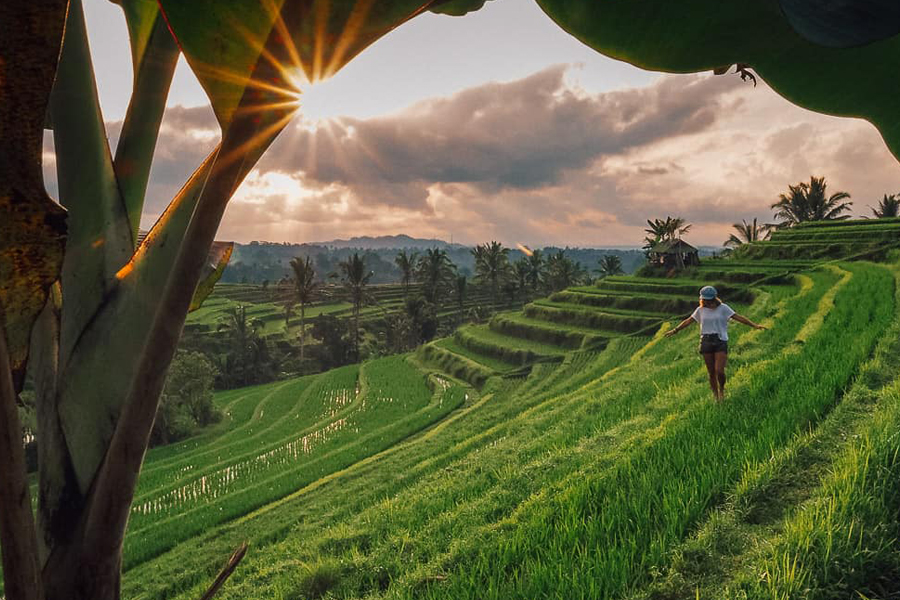
Bali UNESCO World Heritage Sites Tour
★ ★ ★ ★ ★ (834 Reviews)
Explore the beauty of Bali's heritage, visits to iconic sites like Taman Ayun, Ulun Danu Bratan, Handara Gate, Wanagiri Hidden Hill, Jatiluwih Rice Terraces, and witness mesmerizing sunsets at Tanah Lot Temple. The tour includes private transportation, English-speaking guide, lunch, and entrance fees. See Details

North Bali: A Journey of Culture and Nature
★ ★ ★ ★ ★ (769 Reviews)
Uncover North Bali's hidden treasures on this tour! Visit the stunning Ulun Danu Bratan Temple, marvel at the beautiful Banyumala Waterfall, icnic Handara Gate and Twin Lakes. Join us for an adventure to explore Bali's lesser-known wonders! English-speaking guide, lunch, and entrance fees imncluded.See Details
Address & Accessibility
Located in the Tabanan Regency, the Jatiluwih Rice Terraces are a bit off the beaten path, which only adds to their charm. The address is Jatiluwih Village, Penebel, Tabanan Regency, Bali. The drive from Ubud or South Bali takes about 1.5 to 2 hours, depending on traffic.
The roads are well-maintained, but the journey does involve navigating some winding mountain paths. Once you arrive, ample parking is available, and the terraces are easily accessible on foot, with well-marked paths leading you through the lush, green landscape.
Here are the directions to Jatiluwih Rice Terrace from Google Maps:
Best Times to Visit Jatiluwih
The best time to visit Jatiluwih Rice Terraces is during the early morning or late afternoon when the light is soft and the air is cool. These times also offer the best chances to witness the farmers at work, tending to the fields as they have for centuries.
If you want to see the terraces at their most vibrant, plan your visit during the growing season, which typically peaks between March and September. During this time, the rice paddies are lush and green, offering stunning photo opportunities.
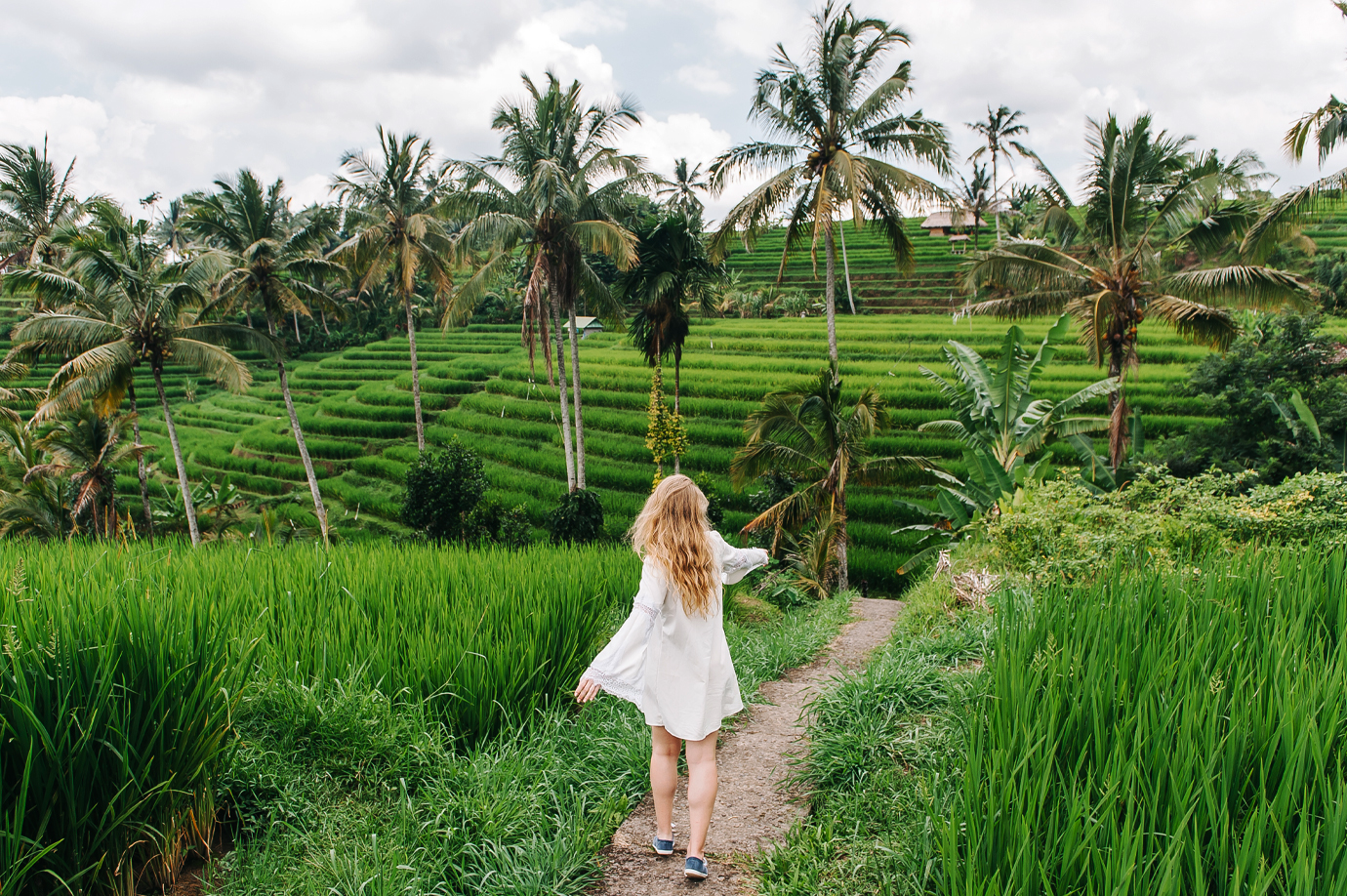
What To See & Do
Jatiluwih is not just a scenic spot; it’s a place where you can fully immerse yourself in Bali’s natural and cultural wonders. Here’s what you can do:
Trekking: Explore the rice terraces on foot along well-marked trails that take you through the heart of Jatiluwih. As you walk, you’ll pass traditional huts, cross small streams, and witness the daily life of the farmers. This is the best way to connect with the land and appreciate the intricate subak irrigation system up close.
Cycling: For those who prefer a more active exploration, cycling through the terraces offers an exhilarating experience. The routes vary in difficulty, catering to both beginners and experienced cyclists. As you pedal along, you’ll discover hidden corners of Jatiluwih that are often missed by other visitors.
Photography: Jatiluwih is a paradise for photographers. The terraces offer endless opportunities for stunning shots, particularly in the early morning or late afternoon when the light is at its most beautiful. Capture the sweeping landscapes, the intricate patterns of the fields, and the timeless beauty of Bali’s rural life.

Jatiluwih Nearby Hotels
If you're looking to truly soak in the peaceful ambiance of Jatiluwih, staying overnight is a must. Here are a couple of cozy places you might want to consider:
- Sang Giri Mountain Glamping gives you a unique experience of luxury camping with stunning views of the mountains and rice fields. Each tent is decked out with modern comforts, making it a perfect spot to enjoy both adventure and relaxation.
- Prana Dewi Mountain Resort offers a tranquil escape with its traditional Balinese bungalows nestled among lush gardens and rice paddies. It's an ideal place to unwind, with yoga sessions, meditation, and guided treks to help you fully embrace the serene surroundings.
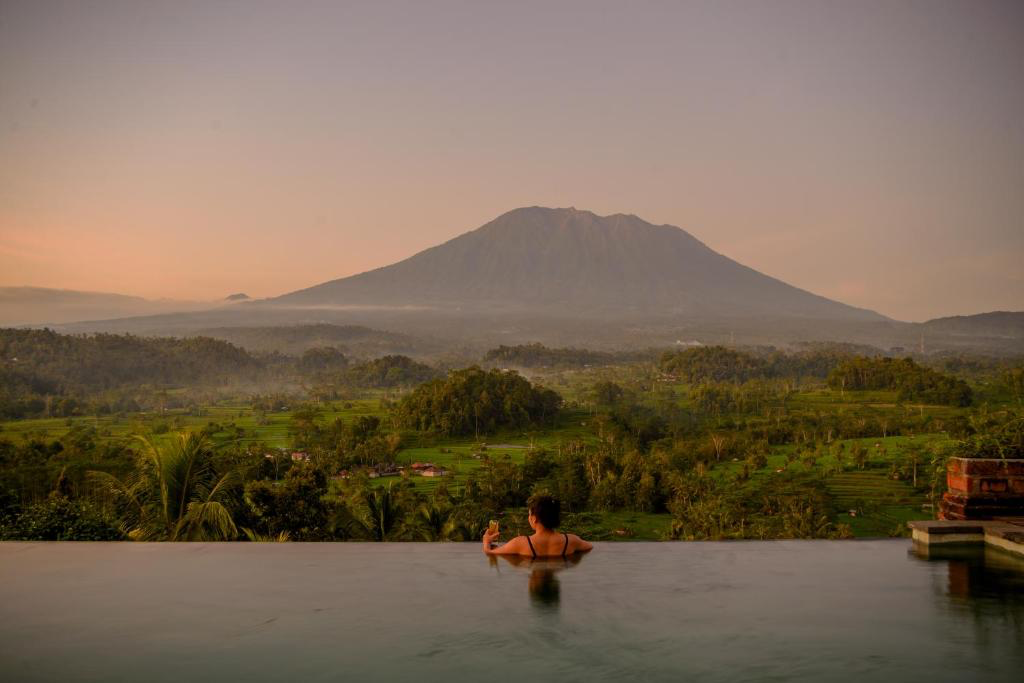
Myths and Legends
Jatiluwih is steeped in myths and legends that add a mystical dimension to its natural beauty. One of the most enduring legends is that of the sacred serpent believed to reside in the mountains above Jatiluwih. This serpent is said to control the flow of water to the terraces, ensuring the fertility of the land. Local farmers make offerings to the serpent during important ceremonies to secure a bountiful harvest.
Another legend tells of Batara Wisnu, the god of agriculture, who blessed Jatiluwih with its extraordinary fertility. According to local belief, Wisnu watches over the terraces, protecting them and the people who work the land. These stories reflect the deep spiritual connection the Balinese have with their environment, viewing the land as a living entity to be revered and respected.
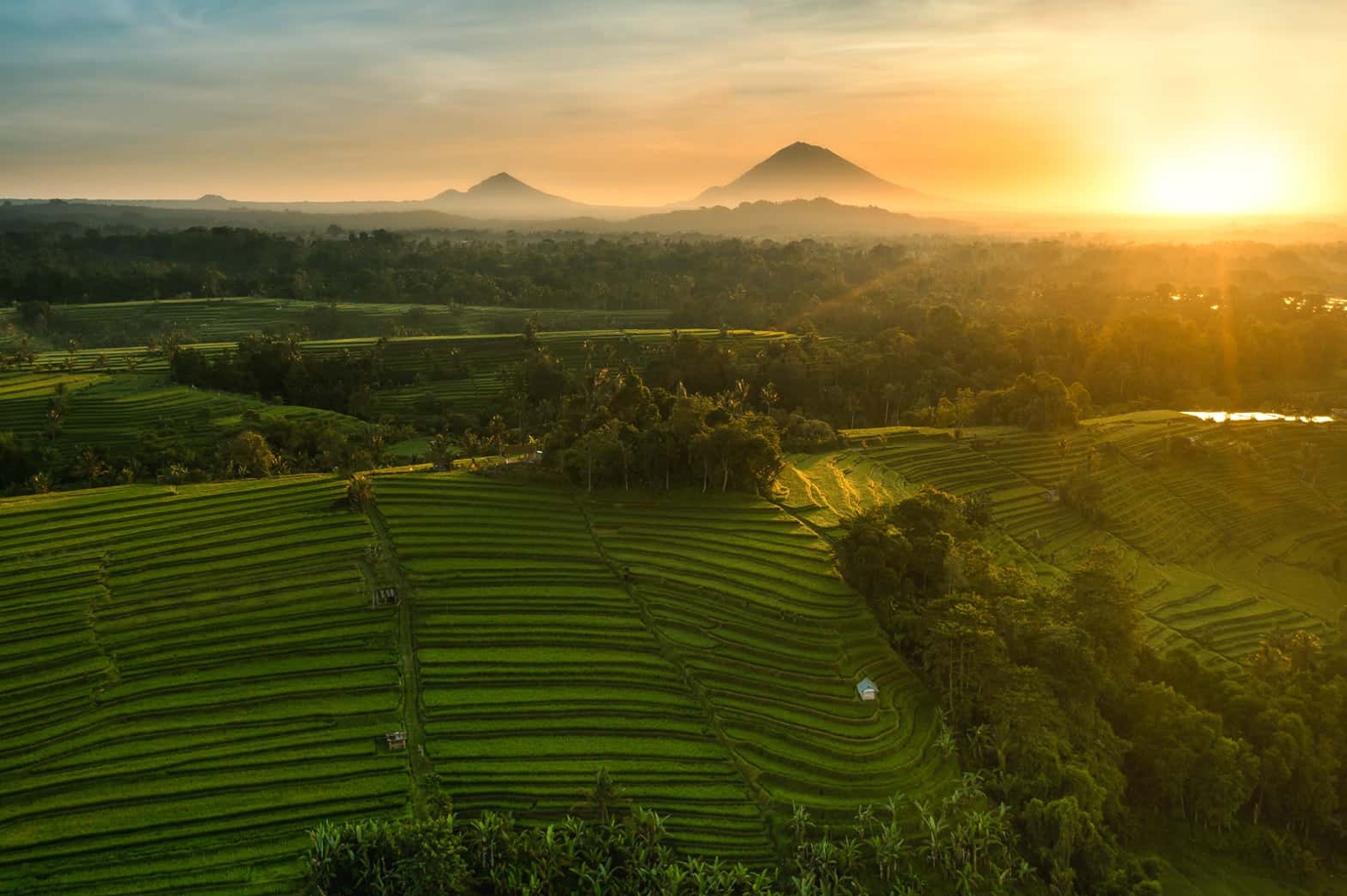
Historical Background
The history of Jatiluwih Rice Terraces is deeply intertwined with the history of Bali itself. These terraces have been cultivated for over a thousand years, with the earliest records of rice farming in the area dating back to the 9th century. The subak system, a sophisticated method of cooperative water management, was developed during this time and remains the backbone of Balinese agriculture.
The subak system is more than just an irrigation method; it embodies the Balinese philosophy of Tri Hita Karana, which promotes harmony between people, nature, and the gods. Managed by a community of farmers, the subak ensures that water is distributed fairly and efficiently, sustaining the rice fields and the community.
Visiting Jatiluwih is like stepping back in time, witnessing a way of life that has remained remarkably consistent despite the changes in the world around it. The terraces are a living reminder of Bali’s cultural heritage and the enduring spirit of its people.

Significance
Jatiluwih Rice Terraces hold immense significance as both a site of natural beauty and a symbol of Bali’s cultural heritage. Recognized by UNESCO as a World Heritage site, Jatiluwih is an outstanding example of a living cultural landscape where human activity and natural processes are perfectly balanced.
The terraces are a testament to the ingenuity and perseverance of the Balinese people, who have managed to cultivate rice on this challenging terrain for centuries. The subak system, which underpins the terraces, is a remarkable achievement of engineering and social organization, ensuring that the water supply is managed sustainably and equitably.
But Jatiluwih is more than just an agricultural marvel. It is a place where the spiritual and the practical meet, where the daily work of farming is infused with a deep sense of respect for the land and its deities. This harmony between humans and nature is what makes Jatiluwih so special and why it continues to inspire visitors from around the world.
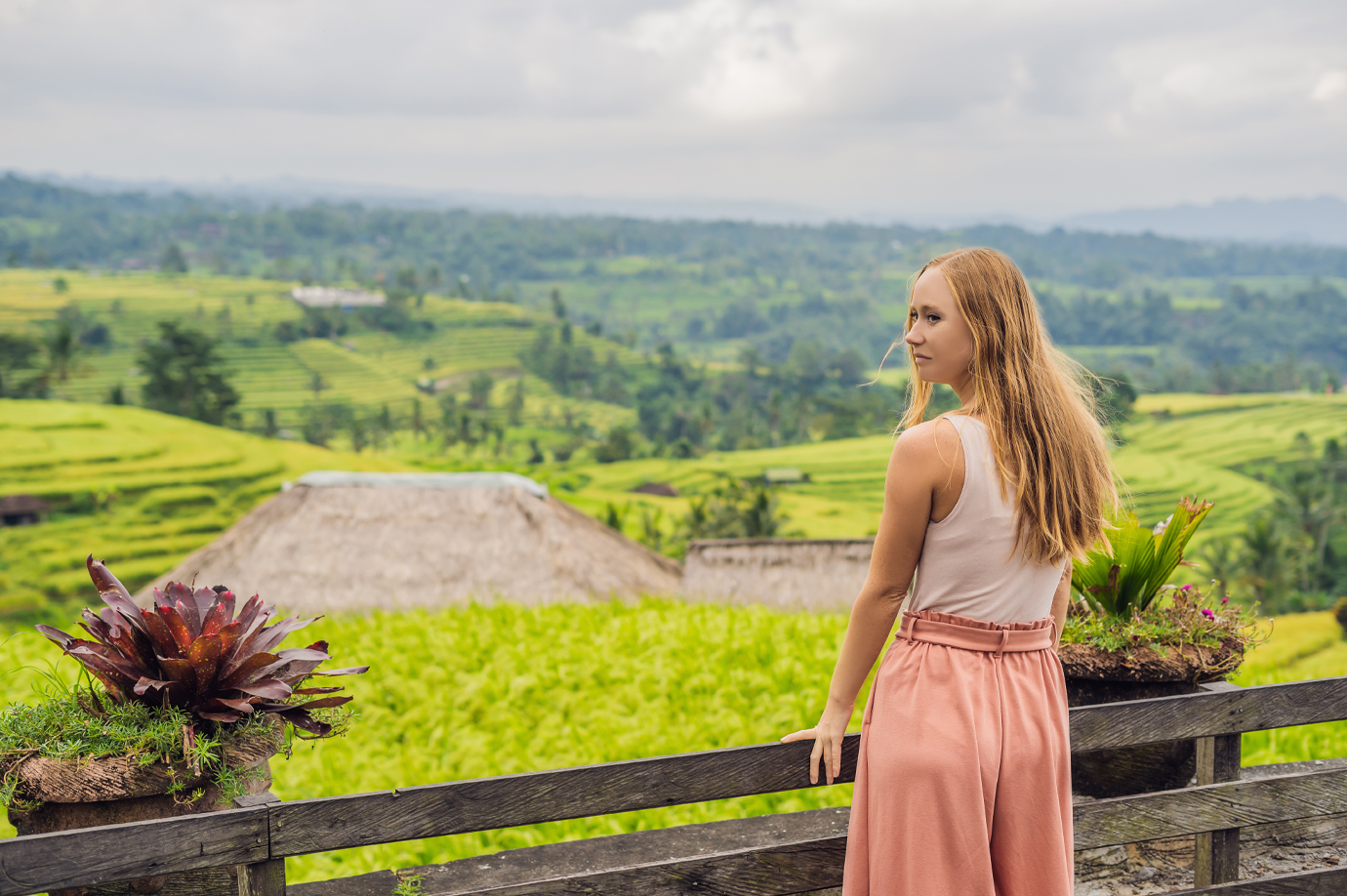
Nearby Restaurants
After exploring Jatiluwih's breathtaking scenery, you'll likely have worked up an appetite. Thankfully, several fantastic dining options are nearby to satisfy your hunger:
Jatiluwih Green Warung: Perfectly situated at the entrance to the terraces, this warung provides a delicious array of traditional Balinese dishes crafted from fresh, local ingredients. The open-air setting offers stunning views of the terraces, creating an ideal atmosphere to unwind and enjoy a meal after your hike.
Billy’s Terrace Café: Nestled on a hillside, Billy’s Terrace Café boasts breathtaking panoramic vistas of the rice fields. The menu features a delightful mix of Balinese and Western cuisine, from classic Nasi Campur to satisfying burgers. It's the perfect place to savor lunch or a refreshing beverage while taking in the picturesque scenery.
Warung Dhea: If you seek a more intimate dining experience, Warung Dhea is an excellent choice. This small, family-run restaurant serves authentic Balinese dishes prepared with love using locally-sourced ingredients. It's a cozy haven where you can truly appreciate the flavors of Bali in a warm and welcoming ambiance.
These restaurants are not just stops along your journey; they are places where you can slow down, savor the moment, and feel the deep connection between the land, its people, and their food.

Capturing the Perfect Photo at Jatiluwih
Capturing the perfect photo at Jatiluwih, Bali, is all about timing, perspective, and embracing the natural beauty of the surroundings. Here are some tips to help you get that stunning shot:
Golden Hour Lighting: The best time to photograph Jatiluwih’s terraced rice fields is during the golden hour—shortly after sunrise or just before sunset. The soft, warm light enhances the vibrant greens of the rice paddies and adds a magical glow to the landscape.
Framing and Composition: Use the natural lines of the terraces to lead the viewer’s eye through the image. Experiment with different angles—get low to the ground to capture the intricate patterns of the fields, or find a higher vantage point to show the vastness of the landscape.
Include Local Life: Adding a human element can bring life to your photo. Capture local farmers working in the fields or villagers going about their daily routines to give a sense of scale and context to the natural beauty.
Weather and Mood: Cloudy skies can add drama to your photos, with mist rising from the fields giving a mystical atmosphere. On the other hand, a clear day allows for bright, vivid images that showcase the lush greenery.
Use a Polarizing Filter: A polarizing filter can reduce glare and enhance the colors of the sky and greenery, making the photo pop with contrast and depth.
Patience and Observation: Take your time to observe the landscape and wait for the right moment. Whether it's the way the light hits the fields or the presence of a farmer in the right spot, patience often results in a more captivating photo.
By combining these techniques, you’ll be able to capture the essence of Jatiluwih and create photographs that truly stand out.

Nearby Attractions to Jatiluwih
While the Jatiluwih Rice Terraces are undoubtedly the star attraction, the surrounding area boasts a wealth of natural and cultural wonders that beckon exploration. Embark on a journey beyond the terraces to discover these hidden gems:
Batukaru Temple: Just a scenic 53-minute drive (13.3 miles) from Jatiluwih lies the serene Batukaru Temple, nestled amidst the lush rainforest on Mount Batukaru's slopes. This ancient Hindu temple, one of Bali's most revered, exudes an air of mystique and tranquility. Wander through its moss-covered courtyards, admire intricate carvings, and feel the spiritual energy that permeates this sacred site. It's a journey into the heart of Balinese devotion and a testament to the island's deep connection to nature and the divine.
Taman Ayun Temple: A short 45-minute drive (12.4 miles) from Jatiluwih will transport you to the enchanting Taman Ayun Temple, also known as the Royal Water Temple. This meticulously landscaped complex, with its elegant moats, multi-tiered shrines, and manicured gardens, showcases the grandeur of the Mengwi Kingdom. As you stroll through its peaceful grounds, you'll be captivated by the harmonious blend of architecture and nature, a reflection of Bali's reverence for balance and beauty.
Tanah Lot Temple: Venture a bit further, about 55 minutes (13.4 miles) from Jatiluwih, to witness the awe-inspiring Tanah Lot Temple. Perched dramatically on a rocky islet amidst the crashing waves, this iconic sea temple is a sight to behold. As the sun dips below the horizon, casting a golden glow on the ancient structure, the scene becomes truly magical. It's a testament to Bali's deep spiritual connection to the sea and a reminder of the island's enduring allure.
These nearby attractions offer a glimpse into the diverse facets of Bali's cultural and spiritual landscape. Each site tells a story, inviting you to delve deeper into the island's rich heritage and experience its timeless beauty. So, venture beyond the terraces and embark on a journey of discovery that will leave you with cherished memories of Bali's enchanting spirit.

Tips for First-Time Visitors
If you’re planning your first trip to Jatiluwih, prepare for an extraordinary experience! With a bit of forethought, you can ensure your visit is not only memorable but also smooth and enjoyable. Here are some suggestions to help you make the most of your trip:
- Dress Appropriately: The trails through the rice terraces at Jatiluwih can be a bit challenging—narrow, uneven, and occasionally steep. It’s important to wear comfortable shoes with good traction. Given the warm and humid climate, opt for light, breathable clothing to stay comfortable.
- Stay Hydrated: The Balinese sun can be quite intense, especially during the dry season. Bring along a water bottle to stay hydrated, and don’t forget a hat and sunscreen. You’ll be grateful you did!
- Respect the Local Culture: Jatiluwih isn’t just a picturesque location—it’s a working agricultural area with significant cultural importance. Be mindful of where you step, avoid trampling the rice plants, and be respectful of the local farmers as they go about their daily tasks.
- Carry Cash: While there may not be a formal entrance fee, local vendors are often selling snacks and handmade souvenirs. Having some cash on hand makes it easier to purchase something unique or offer a small tip.
- Visit Early: For a more serene experience, consider arriving early in the morning. This way, you can avoid the crowds, enjoy the best lighting for photographs, and take advantage of the cooler morning temperatures.
- Take Your Time: The tranquility of Jatiluwih is one of its greatest charms. Don’t rush your visit. Stroll leisurely, take in the stunning views, and fully appreciate the skill and effort required to maintain the terraces.
By following these tips, you’ll be well-prepared for a wonderful visit to Jatiluwih Rice Terraces. Whether you’re there to admire the breathtaking landscape, soak in the cultural atmosphere, or capture that perfect photo, you’ll leave with unforgettable memories.
Author
This captivating guide to Jatiluwih, crafted by Bali Cheapest Tours, invites you to embark on an unforgettable journey through Bali's iconic rice terraces.
Relax within the lush, green landscape as you explore the rich history of these breathtaking fields. Delve into the fascinating world of the remarkable Subak irrigation system, a time-honored tradition that has sustained this stunning landscape for centuries.
Planning Your Bali Trip?
Allow our team to create an unforgettable Balinese experience for you. Please contact us today! We offer a variety of package options to suit your needs.
Let us help you create your dream Bali journey—contact us today! We offer a variety of packages to match your interests and budget.
